Regional Youth Population Prediction Using LSTM
Abstract
1. Introduction
2. Data and Methodology
2.1. Study Area
2.2. Variable Selection
2.3. Methodology
3. Results
3.1. Validation of Predictive Performance of the LSTM Model
3.2. Youth Population Prediction Using LSTM Model
3.3. Interpreting the LSTM Model Using SHAP
4. Discussion
4.1. Youth Population Prediction and Spatial Distribution
4.2. SHAP-Based Interpretation of Influential Factors
4.3. Policy Implications
5. Conclusions
Author Contributions
Funding
Institutional Review Board Statement
Informed Consent Statement
Data Availability Statement
Conflicts of Interest
References
- Álvarez-Montoya, J.M.; Ruiz-Ballesteros, E. Newcomers and Rural Crisis: Beyond the Demographic Challenge. A Case Study in Andalusia (Spain). J. Rural Stud. 2024, 108, 103292. [Google Scholar] [CrossRef]
- Tulibaleka, P.O.; Katunze, M. Rural-Urban Youth Migration: The Role of Social Networks and Social Media in Youth Migrants’ Transition into Urban Areas as Self-Employed Workers in Uganda. Urban Forum 2024, 35, 329–348. [Google Scholar] [CrossRef]
- González-Leonardo, M.; Newsham, N.; Rowe, F. Understanding Population Decline Trajectories in Spain Using Sequence Analysis. Geogr. Anal. 2023, 55, 495–516. [Google Scholar] [CrossRef]
- Shin, H. Analysis of Youth Migration Drivers and Implications for Preparing for Local Extinction. Geogr. J. Korea 2024, 58, 121–134. [Google Scholar] [CrossRef]
- Lee, J.; Shin, Y.; Cho, K. A Regarding Population Concentration in the Metropolitan Area and Disappearance of Local Areas Policy Consideration. J. Land Public Law Stud. 2024, 107, 397–428. [Google Scholar]
- Song, S.; Nam, J. Analysis on Youth Population Movement Patterns and Regional Characteristics in Declining Population Areas: Focused on Outside the Metropolitan Regions. Korea Urban Real Estate Assoc. 2025, 16, 107–135. [Google Scholar]
- Kim, H.; Yang, J. Analysis of Changes in Human Capital Characteristics in Occupational Mobility of College Graduates. Korea Spat. Plan. Rev. 2024, 121, 43–58. [Google Scholar] [CrossRef]
- Yoo, H.B.; Tak, K.J.; Mun, J.S. A Study on the Factors and Overcoming Methods of Extinction of Provinces in Korea: The Exploration with Machine Learning methods. Korean J. Local Gov. Stud. 2021, 24, 443–476. [Google Scholar] [CrossRef]
- Jeon, H.; Lee, G.; Jeon, A. Youth Employment Opportunities and Labor Market Dynamics in Jeonbuk State; Jeonbuk State Institute: Jeonju, Republic of Korea, 2024; Report No. 2024-BR-05. [Google Scholar]
- Lee, S. Capital Region Concentration and Regional Population Crisis Due to Youth Migration. Issue Focus 2020, 395, 1–9. [Google Scholar] [CrossRef]
- Oh, D.; Jung, E.-J.; Kim, S.-Y.; Lee, E.-J.; Choi, E. A Case Study on Social Economy for Counteracting Regional Decline: Focusing on Cases in Chuncheon City. Soc. Econ. Policy Stud. 2024, 14, 113–140. [Google Scholar] [CrossRef]
- Jang, M. Study on Classification of Depopulation Areas According to Crisis of Local Extinction. Geogr. J. Korea 2023, 57, 11–22. [Google Scholar] [CrossRef]
- Ju, S. Local Government Depopulation Status and Policy Alternatives. Korean J. Local Gov. Adm. Stud. 2021, 35, 295–321. [Google Scholar]
- Smith, S.K.; Tayman, J.; Swanson, D.A. A Practitioner’s Guide to State and Local Population Projections; Springer: Berlin/Heidelberg, Germany, 2013. [Google Scholar]
- Park, Y.; Heim LaFrombois, M.E. Planning for Growth in Depopulating Cities: An Analysis of Population Projections and Population Change in Depopulating and Populating US Cities. Cities 2019, 90, 237–248. [Google Scholar] [CrossRef]
- Puga-Gonzalez, I.; Bacon, R.J.; Voas, D.; Shults, F.L.; Hodulik, G.; Wildman, W.J. Adapting Cohort-Component Methods to a Microsimulation: A Case Study. Soc. Sci. Comput. Rev. 2022, 40, 1054–1068. [Google Scholar] [CrossRef]
- Alghanmi, N.; Alotaibi, R.; Alshammari, S.; Mahmood, A. Population Fusion Transformer for Subnational Population Forecasting. Int. J. Comput. Intell. Syst. 2024, 17, 26. [Google Scholar] [CrossRef]
- Kim, Y.; Kim, D. A Study on the Population Estimation of Small Areas using Explainable Machine Learning: Focused on the Busan Metropolitan City. J. Korean Assoc. Geogr. Inf. Stud. 2023, 26, 97–115. [Google Scholar] [CrossRef]
- Qiao, Y.; Wang, C.-W.; Zhu, W. Machine Learning in Long-Term Mortality Forecasting. Geneva Pap. Risk Insur.—Issues Pract. 2024, 49, 340–362. [Google Scholar] [CrossRef]
- Lee, C.; Lee, H. An Analysis on the Determinants of Youth Population Movement across Regions and Prospects. Korean Econ. Bus. Assoc. 2016, 34, 145–171. [Google Scholar]
- Choi, J.; Park, J.; Cho, H. A Study on the Social Migration of Young People and Characteristics in Gyeonggi-Do. J. Korean Cadastre Inf. Assoc. 2023, 25, 34–50. [Google Scholar] [CrossRef]
- Lim, T. A Study on Factors Influencing the Influx of Youth Population into Non-Metropolitan Areas: Focusing on Comparative Analysis by Region and Age Group. Reg. Policy Stud. 2024, 35, 45–64. [Google Scholar]
- Kim, M.; Kang, M. An Analysis of Individual and Regional Factors Influencing Youth Outflow from Non-Capital Regions. J. Korean Urban Manag. Assoc. 2023, 36, 47–66. [Google Scholar] [CrossRef]
- Grossman, I.; Wilson, T.; Temple, J. Forecasting Small Area Populations with Long Short-Term Memory Networks. Socioecon. Plan. Sci. 2023, 88, 101658. [Google Scholar] [CrossRef]
- Riiman, V.; Wilson, A.; Milewicz, R.; Pirkelbauer, P. Comparing Artificial Neural Network and Cohort-Component Models for Population Forecasts. Popul. Rev. 2019, 58, 2. [Google Scholar] [CrossRef]
- Tanmoy, F.M.; Hossain, Z.; Tasfia, O.; Abrar Hamim, M.; Sadekur Rahman, M.; Tarek Habib, M. Machine Learning Modeling for Population Forecasting; Springer Nature: Singapore, 2024; pp. 213–228. [Google Scholar]
- Ko, M.; Kim, K. A Study on the Causes and Factors Explaining the Korean Local Extinction Risk. J. Korean Urban Geogr. Soc. 2021, 24, 17–27. [Google Scholar] [CrossRef]
- Park, J.; Kim, D. Policy Directions to Attract and Retain Youth Population in Response to Regional Population Decline; Basic Research Project; Korea Research Institute for Local Administration: Wonju, Republic of Korea, 2020; Volume 40, p. 405. [Google Scholar]
- Kim, M.; Yoon, S.; Kim, D. Specialized Plan for Living Conditions in Region area in Response to Local Extinction. J. Korean Reg. Dev. Assoc. 2023, 35, 43–64. [Google Scholar] [CrossRef]
- Kim, S.; Lee, S.; Cho, D. Exploring the Impact of Youth Migration on Population Redistribution. J. Korean Cartogr. Assoc. 2024, 24, 73–88. [Google Scholar] [CrossRef]
- Hochreiter, S. The Vanishing Gradient Problem during Learning Recurrent Neural Nets and Problem Solutions. Int. J. Uncertain. Fuzziness Knowl.—Based Syst. 1998, 6, 107–116. [Google Scholar] [CrossRef]
- Yang, J.; Heo, J.; Kim, J.; Park, Y.; Chu, H.; Park, Y. Deep Neural Network-Based Time Series Atmospheric Refractivity Prediction Model Using Meteorological Observation Data. J. Korean Inst. Electromagn. Eng. Sci. 2023, 34, 860–863. [Google Scholar] [CrossRef]
- Lee, C.; Lee, J.; Park, S. Forecasting the Urbanization Dynamics in the Seoul Metropolitan Area Using a Long Short-Term Memory–Based Model. Environ. Plan. B Urban Anal. City Sci. 2023, 50, 453–468. [Google Scholar] [CrossRef]
- Bravo, J.M. Forecasting Mortality Rates with Recurrent Neural Networks: A Preliminary Investigation Using Portuguese Data. In Proceedings of the CAPSI 2021 21ª Conferência da Associação Portuguesa de Sistemas de Informação, “Sociedade 5.0: Os desafios e as Oportunidades para os Sistemas de Informação”, Setubal, Portugal, 13–16 October 2021. [Google Scholar]
- Schnaubelt, M. A Comparison of Machine Learning Model Validation Schemes for Non-Stationary Time Series Data; FAU Discussion Papers in Economics; Friedrich-Alexander University Erlangen-Nürnberg: Erlangen, Germany, 2019. [Google Scholar]
- Hong, Y.-B.; Choi, J.-D. Prediction of KOSPI Index by Time Series based on Convergence Model using Cross-Validation of Time Series Data. J. Korean Oper. Res. Manag. Sci. Soc. 2023, 48, 1–21. [Google Scholar] [CrossRef]
- Seo, Y.; Baek, C. A Comparative Study on Cross-Validation Methods for Deep Learning Models in Time Series Prediction. J. Korean Data Inf. Sci. Soc. 2024, 35, 397–410. [Google Scholar]
- Cerqueira, V.; Torgo, L.; Mozetič, I. Evaluating Time Series Forecasting Models: An Empirical Study on Performance Estimation Methods. Mach. Learn. 2020, 109, 1997–2028. [Google Scholar] [CrossRef]
- Deng, A. Time Series Cross Validation: A Theoretical Result and Finite Sample Performance. Econ. Lett. 2023, 233, 111369. [Google Scholar] [CrossRef]
- Stone, M. Cross-Validation and Multinomial Prediction. Biometrika 1974, 61, 509–515. [Google Scholar] [CrossRef]
- Wagner, F.; Milojevic-Dupont, N.; Franken, L.; Zekar, A.; Thies, B.; Koch, N.; Creutzig, F. Using Explainable Machine Learning to Understand How Urban Form Shapes Sustainable Mobility. Transp. Res. Part Transp. Environ. 2022, 111, 103442. [Google Scholar] [CrossRef]
- Luo, P.; Chen, C.; Gao, S.; Zhang, X.; Majok Chol, D.; Yang, Z.; Meng, L. Understanding of the Predictability and Uncertainty in Population Distributions Empowered by Visual Analytics. Int. J. Geogr. Inf. Sci. 2025, 39, 675–705. [Google Scholar] [CrossRef]
- Sunkpho, J.; Se, C.; Wipulanusat, W.; Ratanavaraha, V. SHAP-Based Convolutional Neural Network Modeling for Intersection Crash Severity on Thailand’s Highways. IATSS Res. 2025, 49, 27–41. [Google Scholar] [CrossRef]
- Lai, Y.; Sun, W.; Schmöcker, J.-D.; Fukuda, K.; Axhausen, K.W. Explaining a Century of Swiss Regional Development by Deep Learning and SHAP Values. Environ. Plan. B Urban Anal. City Sci. 2023, 50, 2238–2253. [Google Scholar] [CrossRef]
- Lee, E. Exploring Transit Use during COVID-19 Based on Xgb and SHAP Using Smart Card Data. J. Adv. Transp. 2022, 2022, 6458371. [Google Scholar] [CrossRef]
- Yu, B.; Li, H.; Xing, H.; Ge, W.; Zhou, L.; Zhang, J.; Xu, M.; Yu, C. Geospatial SHAP Interpretability for Urban Road Collapse Susceptibility Assessment: A Case Study in Hangzhou, China. Geomat. Nat. Hazards Risk 2025, 16, 2491473. [Google Scholar] [CrossRef]
- Wang, Y.; Hu, L.; Hou, L.; Wang, L.; Chen, J.; He, Y.; Su, X. A SHAP Machine Learning-Based Study of Factors Influencing Urban Residents’ Electricity Consumption-Evidence from Chinese Provincial Data. Environ. Dev. Sustain. 2024, 26, 30445–30479. [Google Scholar] [CrossRef]
- Wang, M.; Li, Y.; Yuan, H.; Zhou, S.; Wang, Y.; Ikram, R.M.A.; Li, J. An XGBoost-SHAP Approach to Quantifying Morphological Impact on Urban Flooding Susceptibility. Ecol. Indic. 2023, 156, 111137. [Google Scholar] [CrossRef]
- Akter, R.; Susilawati, S.; Zubair, H.; Chor, W.T. Analyzing Feature Importance for Older Pedestrian Crash Severity: A Comparative Study of DNN Models, Emphasizing Road and Vehicle Types with SHAP Interpretation. Multimodal Transp. 2025, 4, 100203. [Google Scholar] [CrossRef]
- Ko, J.; Lee, J.; Ku, J. A Study on the Improvement: Local Investment Support Schemes for Local Industry Development and Activation. J. Korean Reg. Dev. Assoc. 2023, 35, 45–68. [Google Scholar]
- Cha, G.; Lim, S. An Analysis of Population Change and the Estimation of the Regional Vitality Index in Small Cities of Non-Capital Areas. J. Korean Assoc. Reg. Geogr. 2023, 57, 111–128. [Google Scholar]
- Sa, H. A Study on the Spatial Distribution Patterns and Agglomeration Factors of Emerging Industries. J. Korean Econ. Geogr. Soc. 2020, 23, 125–146. [Google Scholar]
- Jang, M. Analysis of the Impact of Young Adults’ Social Capital on Regional Mobility. J. Gener. Converg. Technol. Assoc. 2024, 8, 1624–1635. [Google Scholar] [CrossRef]
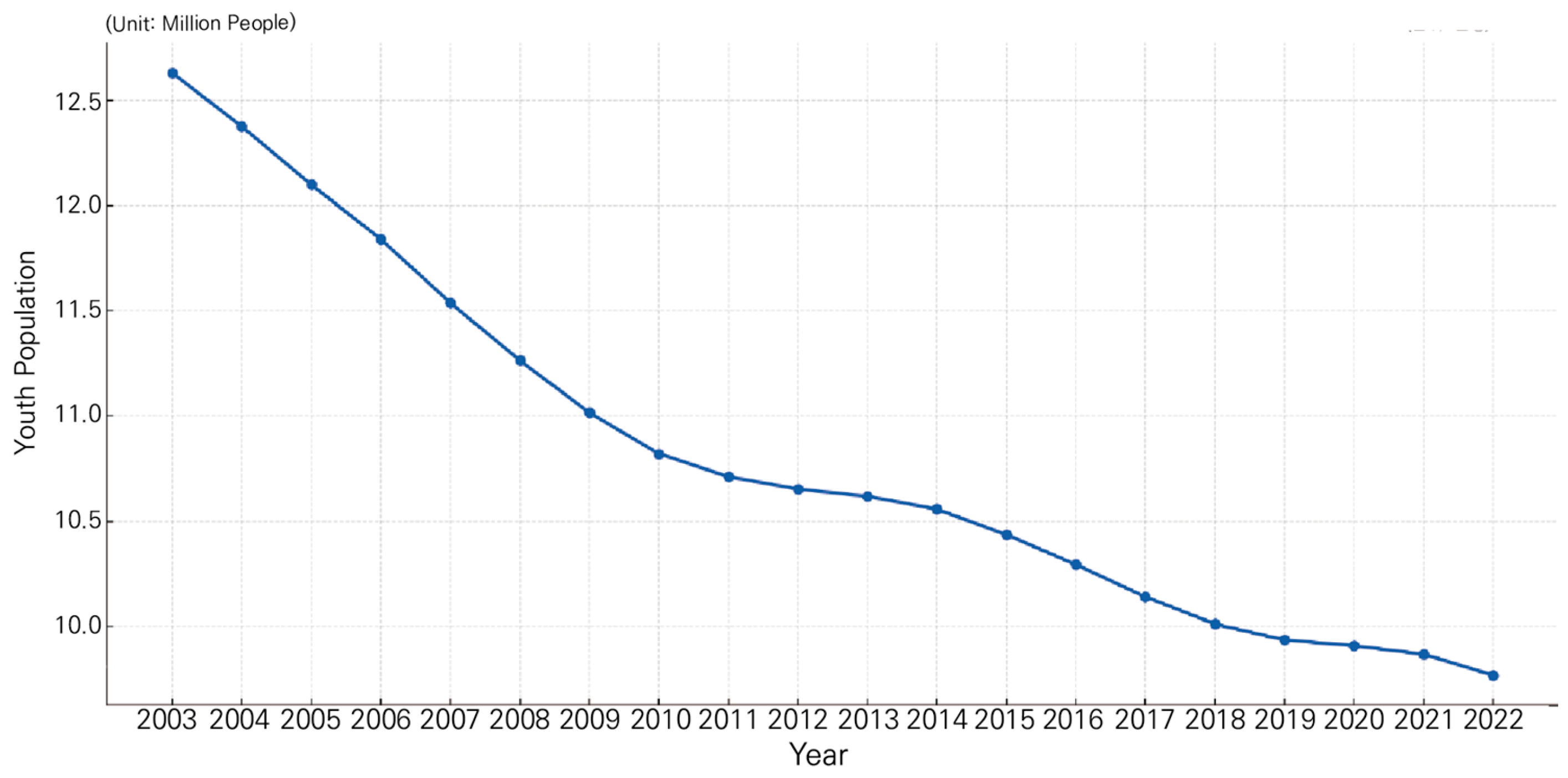
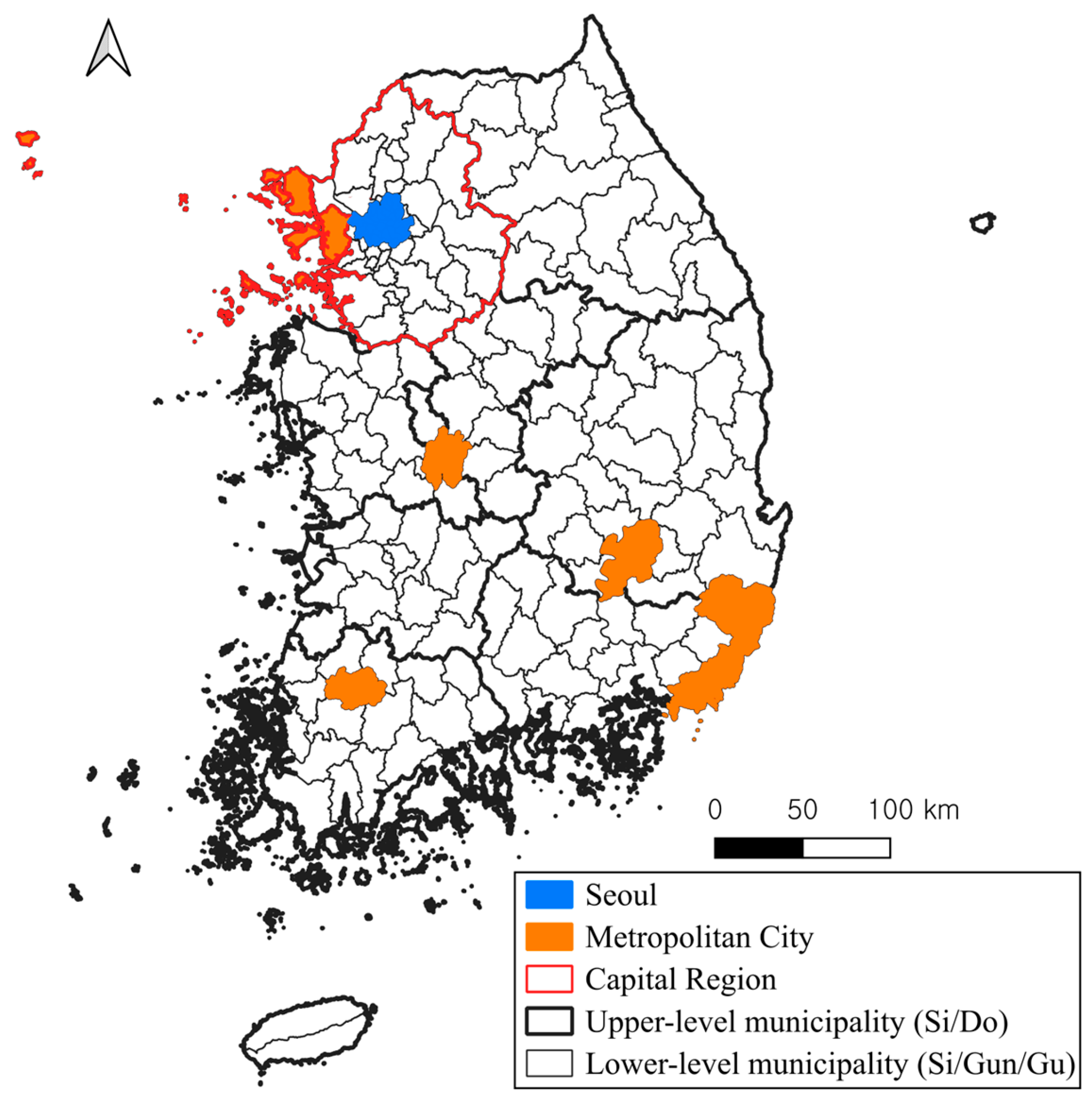
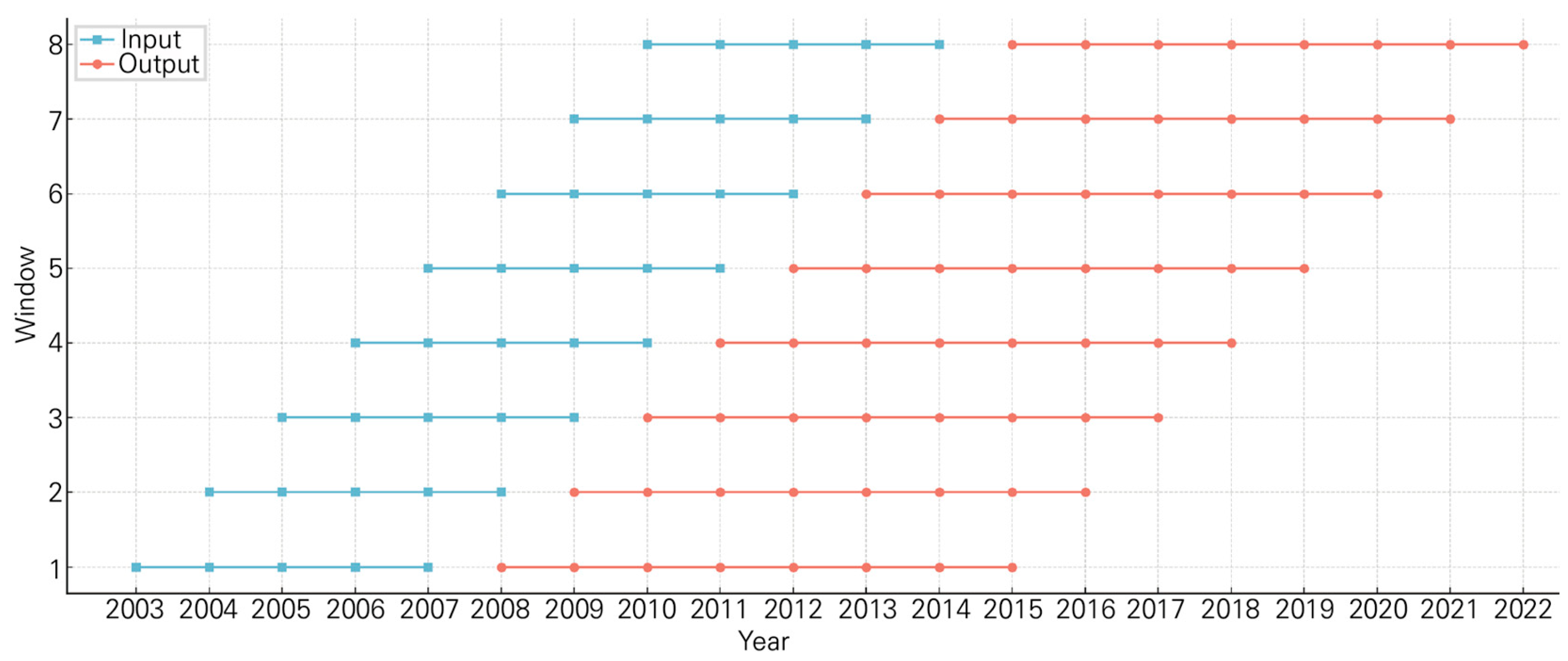
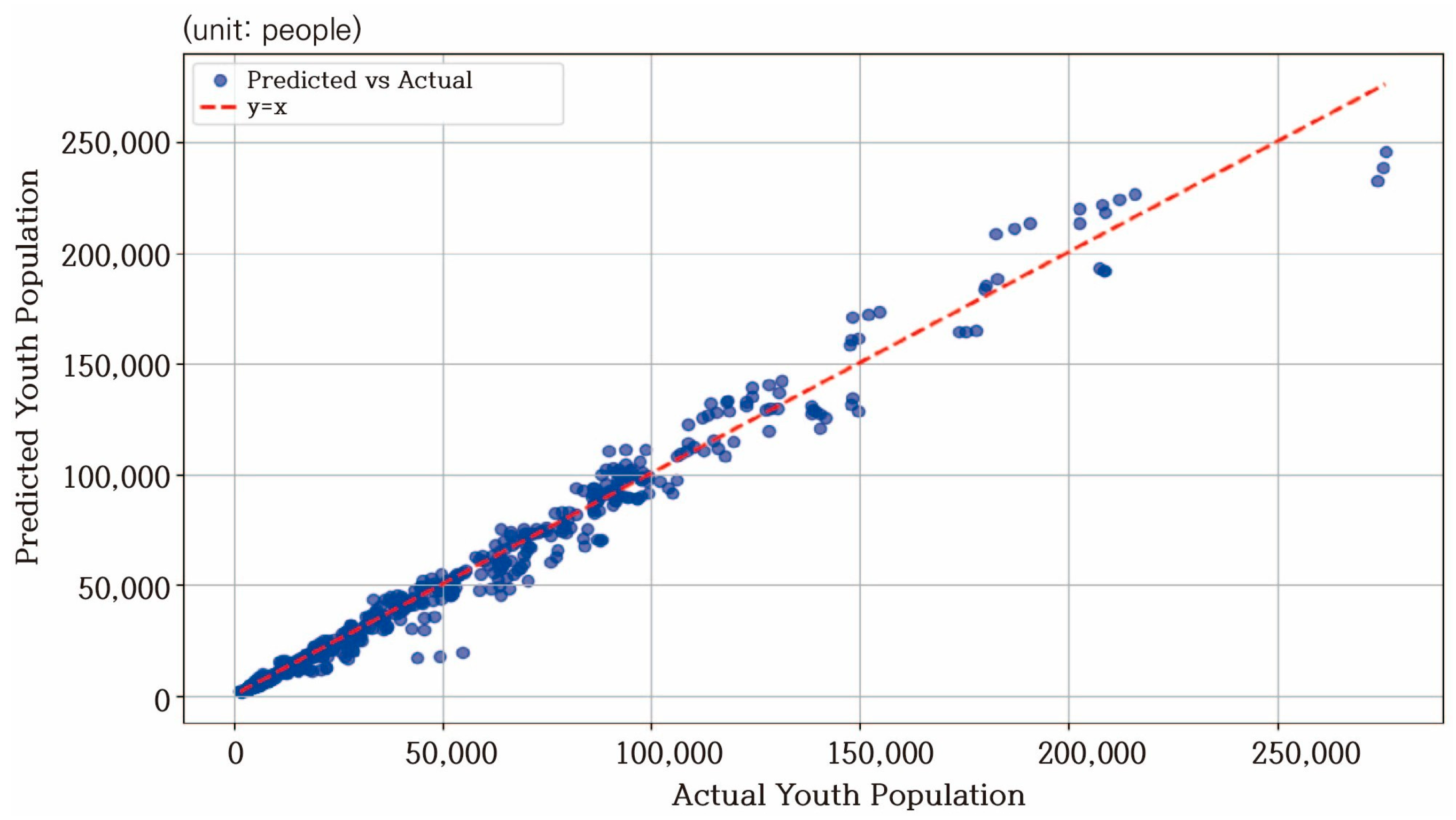
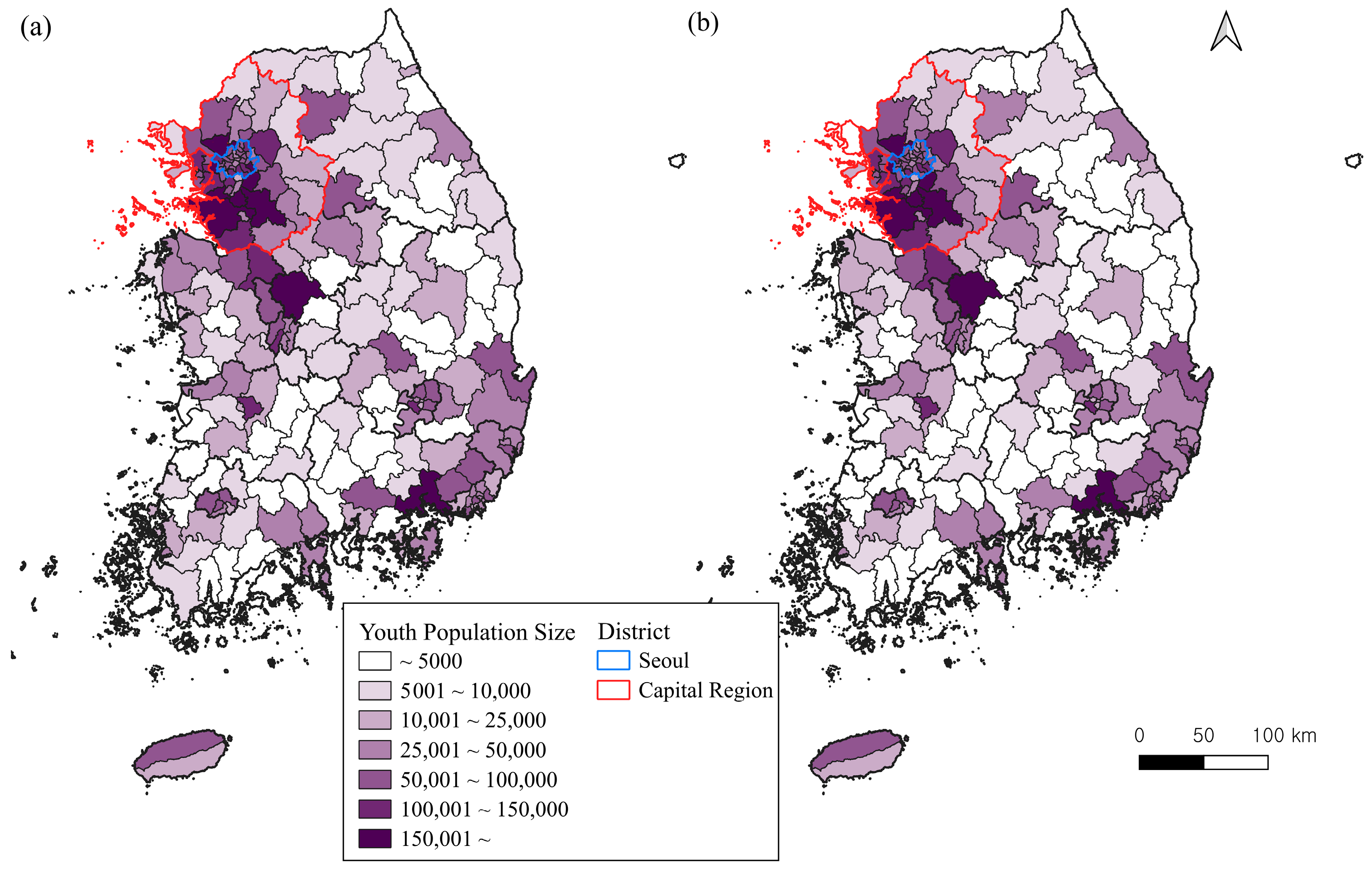
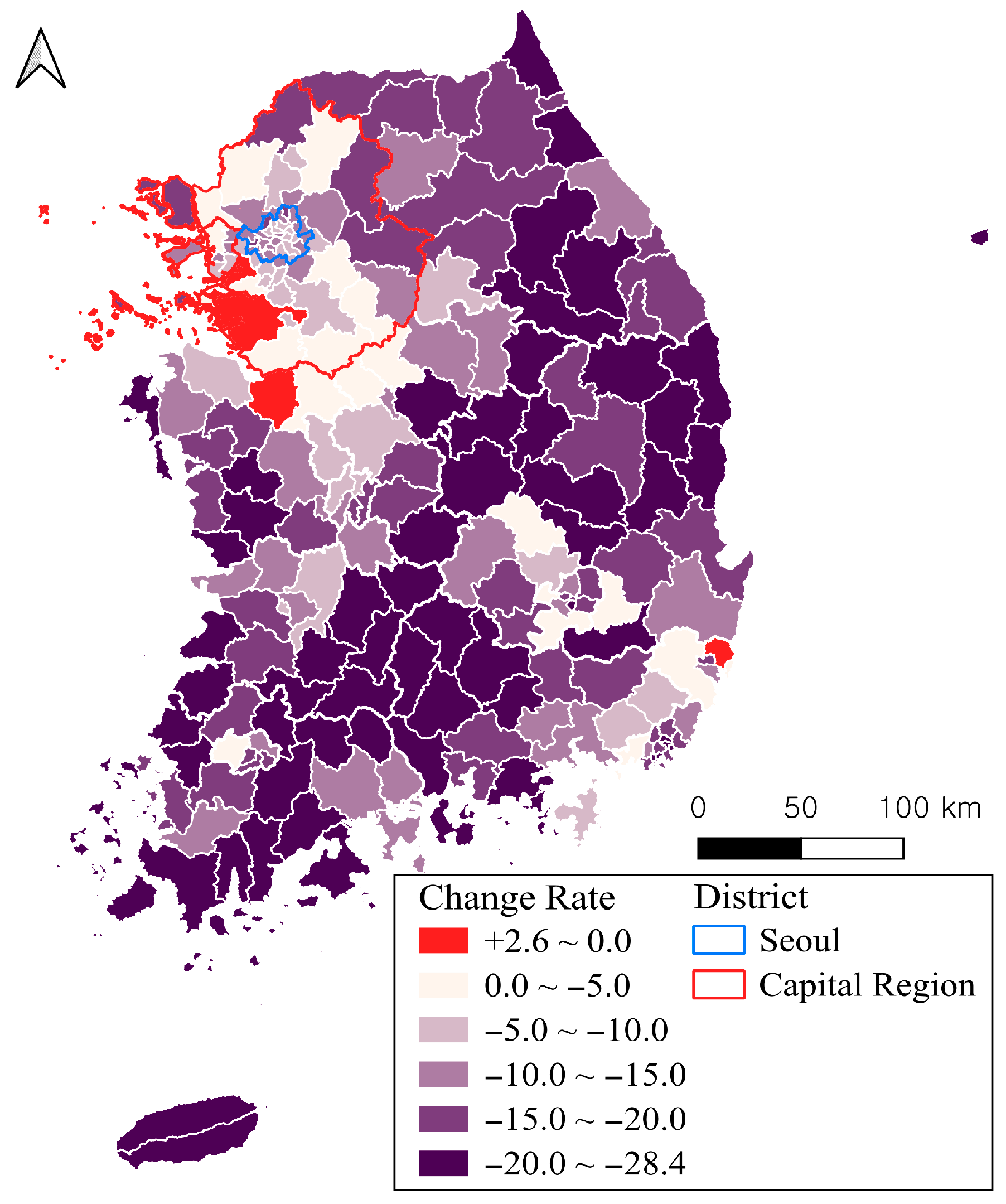
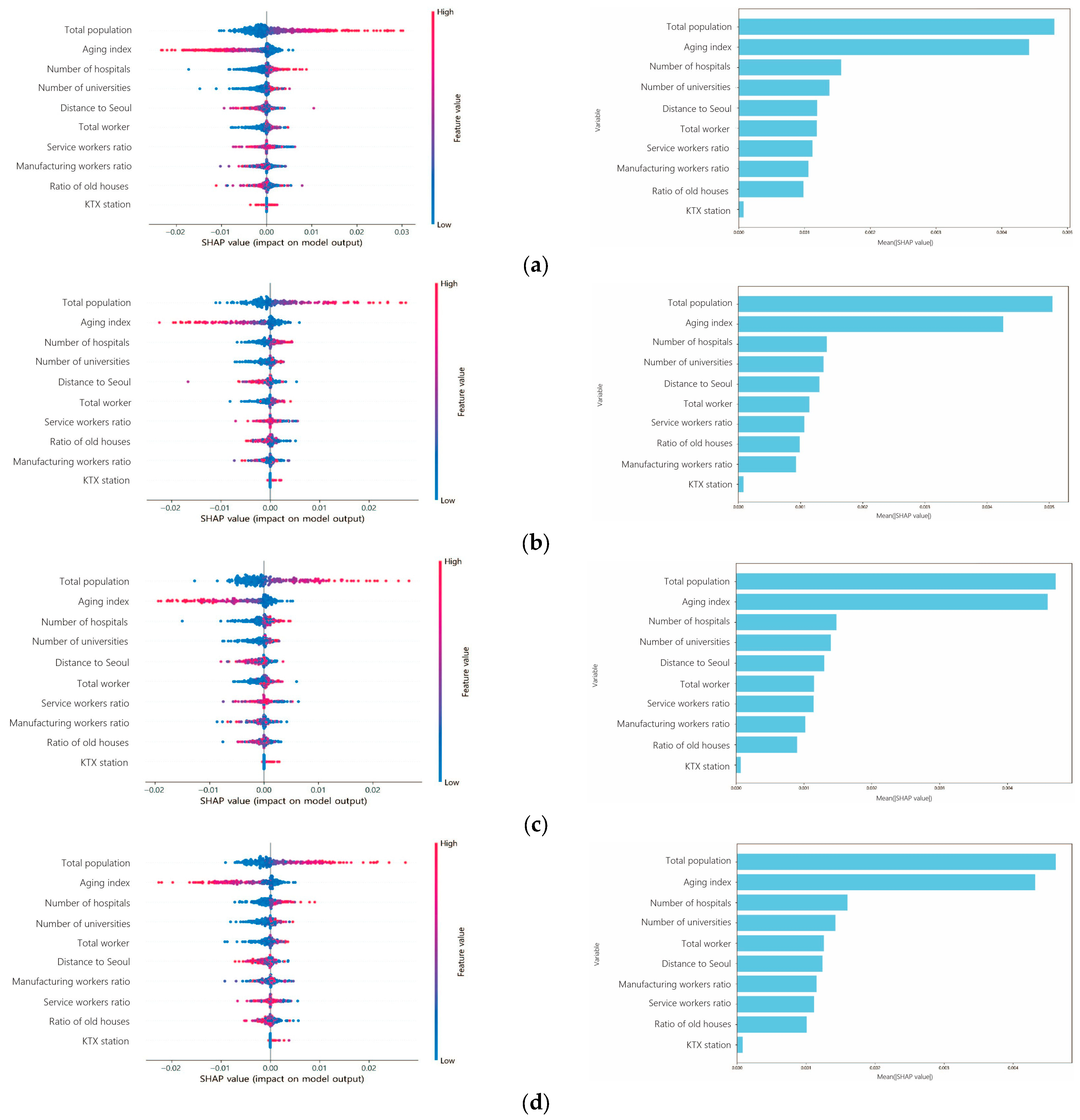
| Variable | Variable Name | Description | Source | |
|---|---|---|---|---|
| Target | Youth population | Number of population aged 19–34 | KOSIS | |
| Feature | Population | Aging index | Ratio of population aged 65+ to population aged 0–14 | KOSIS |
| Total population | Total number of populations | KOSIS | ||
| Industry | Total workers | Total number of workers | SGIS | |
| Proportion of manufacturing workers | Ratio of manufacturing workers to total workers | SGIS | ||
| Proportion of service workers | Ratio of service industry workers to total workers | SGIS | ||
| Infrastructure | Number of universities | Number of universities | MOE | |
| Number of hospitals | Number of hospitals | HIRA | ||
| KTX stations (dummy) | 1 if a KTX station exists, otherwise 0 | MOLIT | ||
| Urban Characteristics | Proportion of old houses | Ratio of houses over 30 years old to total number of houses | KOSIS | |
| Distance to Seoul | Distance to Seoul from the centroid | KOSIS | ||
| Hyperparameter | Value |
|---|---|
| Units | 50 |
| Dropout | 0.1 |
| Layers | 2 |
| Optimizer | rmsprop |
| Epochs | 100 |
| Batch size | 16 |
| Patience | 10 |
| Evaluation Metric | Train Set | Test Set |
|---|---|---|
| RMSE | 6431.183 | 7421.283 |
| MAE | 3662.510 | 4041.275 |
| MAPE | 9.173 | 10.086 |
| R2 | 0.982 | 0.975 |
| Model | RMSE | MSE | MAE |
|---|---|---|---|
| (a) | |||
| LSTM | 23,908.27 | 571,605,203 | 15,792.35 |
| Statistics Korea: Low | 29,751.86 | 885,172,984 | 22,992.47 |
| Statistics Korea: Medium | 29,757.49 | 885,508,487 | 22,998.71 |
| Statistics Korea: High | 29,764.95 | 885,952,257 | 23,005.12 |
| (b) | |||
| LSTM | 32,373.77 | 1,048,061,224 | 19,109.88 |
| Statistics Korea: Low | 31,584.97 | 997,610,484 | 24,391.59 |
| Statistics Korea: Medium | 34,168.37 | 1,167,477,230 | 26,249.65 |
| Statistics Korea: High | 36,814.02 | 1,355,271,789 | 28,136.76 |
| (c) | |||
| LSTM | 29,592.46 | 875,713,525 | 18,629.76 |
| Statistics Korea: Low | 30,058.16 | 903,492,829 | 23,143.00 |
| Statistics Korea: Medium | 34,769.18 | 1,208,896,584 | 26,399.00 |
| Statistics Korea: High | 39,675.69 | 1,574,160,114 | 29,832.47 |
Disclaimer/Publisher’s Note: The statements, opinions and data contained in all publications are solely those of the individual author(s) and contributor(s) and not of MDPI and/or the editor(s). MDPI and/or the editor(s) disclaim responsibility for any injury to people or property resulting from any ideas, methods, instructions or products referred to in the content. |
© 2025 by the authors. Licensee MDPI, Basel, Switzerland. This article is an open access article distributed under the terms and conditions of the Creative Commons Attribution (CC BY) license (https://creativecommons.org/licenses/by/4.0/).
Share and Cite
Seo, J.; Yoon, S.; Kim, J.; Kwon, K. Regional Youth Population Prediction Using LSTM. Sustainability 2025, 17, 6905. https://doi.org/10.3390/su17156905
Seo J, Yoon S, Kim J, Kwon K. Regional Youth Population Prediction Using LSTM. Sustainability. 2025; 17(15):6905. https://doi.org/10.3390/su17156905
Chicago/Turabian StyleSeo, Jaejun, Sunwoong Yoon, Jiwoo Kim, and Kyusang Kwon. 2025. "Regional Youth Population Prediction Using LSTM" Sustainability 17, no. 15: 6905. https://doi.org/10.3390/su17156905
APA StyleSeo, J., Yoon, S., Kim, J., & Kwon, K. (2025). Regional Youth Population Prediction Using LSTM. Sustainability, 17(15), 6905. https://doi.org/10.3390/su17156905






